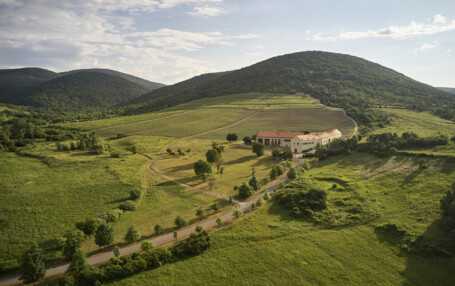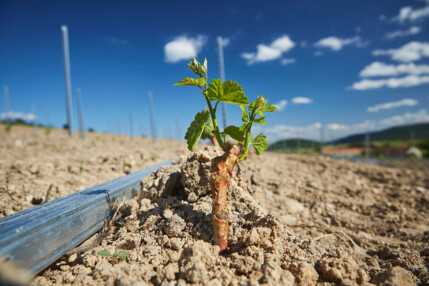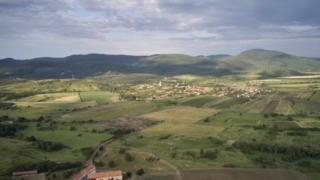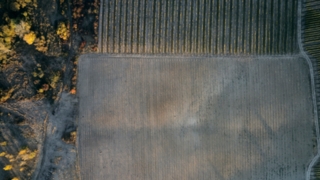LEGENDARY WINES OF A LEGENDARY VINEYARD
Sprawling over 15 hectares over the south–south-eastern slopes of the 420‑metre high Tolcsva‑Peres Hill, Lőcse-dűlő is an especially important part of the 45-hectare Béres Vineyards and Winery.
In 2002 Béres Vineyards and Winery started out on 10 hectares on the lower slopes of Lőcse‑dűlő. These 10 hectares yielded the first Béres wines in 2003. The area, which lies directly over the Estate Centre, was first planted in the early 1980’s with the direction of the then‑owner State Winery. We liked to simply call it “Old Lőcse” to make it clear we were not talking about “New Lőcse”, the Furmint plantation created on the previously uncultivated higher slopes in 2005. After 2020 we decided to modernise the “Old Lőcse” area creating a 5,000 vine‑per‑hectare vineyard.
In fact, this is the vineyard where our story began.
We remember looking around here and seeing Erdőbénye for the very first time... it was love at first sight. Produced since 2003, our Lőcse Furmint wines soon became the iconic dry white wines of our winery. Those who appreciate barrel‑aged Furmint wines of full‑bodied deepness will find these wines genuinely exciting – after all, it is for a reason they have received several prizes in Hungarian and international competitions and have become so popular with many a wine aficionado.
The vintages of our Lőcse Furmint have won competitions including, among many others, the Pannon Wine Challenge, Wine of the Hungarian Parliament, Wine of the Semmelweis University, VinAgora, Decanter World Wine Awards, International Wine Challenge and Challenge International du Vin, on a regular basis. The 2007 Béres Lőcse Furmint has been given the highest score amongst all tested dry white wines (93) in Neil Martin’s test on the website of renowned international wine journalist Robert Parker. We take these achievements as confirmation that the Tokaj Wine Region is not just suitable for producing dry Furmint wines, it can – and should – be pursued on a high level.

A Storyful Past
We have always been keen on knowing the place where we belong – that we are part of. Tokaj‑Hegyalja is no exception. Its history, going back all the way to the middle ages and its geology, encompassing millions of years, is important to us. Delving deep into the history of Tokaj‑Hegyalja, our historian friends István Zelenák and Kornél Nagy have provided us with some really interesting facts about Lőcse‑dűlő. Thanks to their work we have learned that the first known owner of the hill was a man named Gotki (or Gothky) of the town of Lőcse who then bequeathed the area to the Lehnice monastery at the end of the 15th century. A 1507 record mentions the hillside as “Gotki vineyard” named after the original owner.

Why “Lőcse”?
Lőcse – today Levoča in Slovakia – used to be a historical town of Hungary, about 100 kilometres from Lőcse‑dűlő. To understand the name of Lőcse‑dűlő we have to go back all the way to the 16th century, when the town of Lőcse purchased land to grow wine, near Erdőbénye. They bought the plot from the Szabó family in 1577 and, as was customary at the time, named the area after the previous owner: from 1578 the Lőcse accounts mention the area as “György Szabó Vineyard”. Given its excellent natural characteristics, the hill would later draw the interest of the Prince of Transylvania, George I Rákóczi who, in several moves between 1623 and 1644 basically seized the plot by force. The name Lőcse first appeared in 1644 for this area.
Our family sees this connection with the Felvidék – Upper Hungary – as a great value. This is why we invited the Mayor of Lőcse to the winery’s opening ceremony in 2006 which the Mayor was kind enough to accept, attending the event. Founders of the estate József and Klára Béres returned the visit two years later. In 2010 the estate hosted a meeting of the mayors, and at our 15‑year anniversary we could once again welcome the representatives of Lőcse. Past has met present.
The geological history and resulting present‑day soil characteristics of the area are extremely interesting from the aspect of wine cultivation. The top layer of the Erdőbénye Basin is exclusively volcanic in origin. Lőcse‑dűlő lies on primarily rhyolitic tuff and to a smaller extent vesicular rhyolite roughly 100 metres in thickness.
The wine plantations are located on the clayey residual soil and at places erubase soil. The high soil content gives these soil types excellent rainwater retention capabilities; however, rainwater coming down the steep slopes causes considerable erosion.
A walk in Lőcse‑dűlő is, in essence, a tour of petrology. The clayey residual soil contains rhyolitic tuff and other types of volcanic rock fragments: rhyolite, pumice and obsidian from higher up the slopes, as well as minerals, such as flint and opal: the products of postvolcanic hydrothermal metamorphism.

Opened in 2018 our educational trail “Wine‑growing Man and Nature” (“A szőlőművelő ember és a természet”) provides our visitors with a detailed description of Lőcse‑dűlő. A truly wonderful place, the hill and the trail are well worth a visit. When sipping a glass of Lőcse Furmint in the comfort of the estate patio after the hike, time may seem to stand, and you will feel like you truly belong here.






